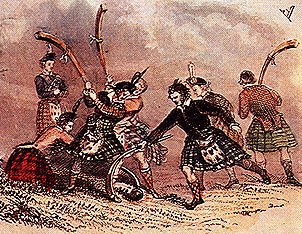Shinty
by Per G Olsson
 Shinty is played by about 40 clubs, mainly in the Scotish Highlands.
When the rules of Shinty were getting formalised there was a long-going feud
over if Shinty should be played in kilts or not (modern shinty isn't)
and if gaelic should be the only language allowed.
Shinty is played by about 40 clubs, mainly in the Scotish Highlands.
When the rules of Shinty were getting formalised there was a long-going feud
over if Shinty should be played in kilts or not (modern shinty isn't)
and if gaelic should be the only language allowed.
After these differences were sorted out, the sport got more unified and organised in the late 19th century and the oldest trophy still contested is the Camanachd (Gaelic for Shinty) Association Challange Cup, which Kingussie was the first to win in 1896. A few clubs have dominated Shinty in it's 100+ history: Newtonmore, Kyles Athletic and Kingussie have won over two-thirds of the finals.
The similarity of Shinty to Bandy and Hurling is obvious, the grass pitch is similar to that of Hurling and larger than that of Bandy: 130-155m by 65-70m and the goals are much larger than Bandy goals: 3.66m wide and 3.05m high.
Shinty is played by twelve players compared to the eleven of Bandy. Corners are taken like in Football, the off-side rule is identical to that of Hurling, i.e. no attacking player is allowed enter the goal area (ten yard area) before the ball, goals are counted as in Bandy and Football, with which Shinty also share the duration of play (2x45 mins). There is no rule against high sticks like the one in Bandy.
 As both Hurling and Shinty lack international games and are quite similar,
an annual hybrid game is played involving under 21 sides. The Irish have
been winning most of these internationals, which is not too surprising as
Hurling has a greater player base and the simple fact that the Hurling stick
has a larger head than the Shinty stick. Still it's a great occasion for the
up and coming.
As both Hurling and Shinty lack international games and are quite similar,
an annual hybrid game is played involving under 21 sides. The Irish have
been winning most of these internationals, which is not too surprising as
Hurling has a greater player base and the simple fact that the Hurling stick
has a larger head than the Shinty stick. Still it's a great occasion for the
up and coming.
Hurling rules and other information: http://www.gaa.ie/